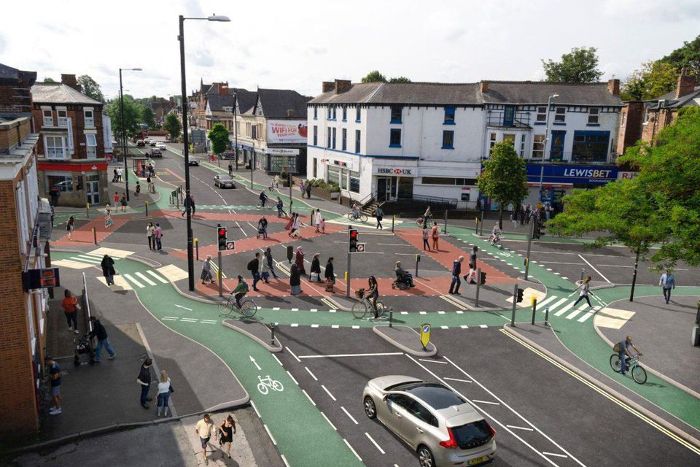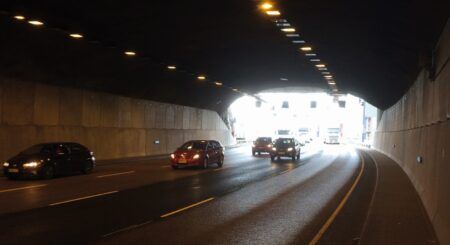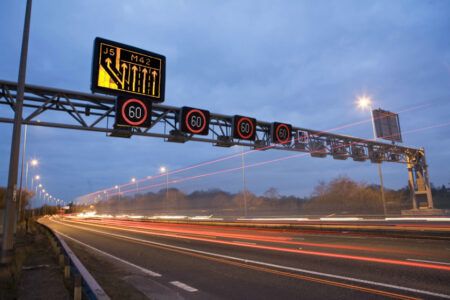Traffic engineers working for Transport for Greater Manchester (TfGM) in the UK have developed a unique approach to junction design that is being applauded both nationally and internationally for its increased safety for both cyclists and pedestrians.
First presented at the UK’s Traffic Signal Symposium in September 2018, the Cycle Optimized Protected Signals (CYCLOPS) junction design approach maximizes the opportunities for safe cycling and walking, while simultaneously optimizing the overall junction performance for all transport modes. The principle feature of a CYCLOPS junction is an orbital cycle route separating cyclists from motor traffic, reducing the possibility of collisions or conflicts. People on foot are also able to get exactly where they want to be in fewer stages with more space to wait than on other junction designs. The junctions will be a key feature of Greater Manchester’s Bee Network, a plan to deliver the UK’s largest cycling and walking network. The first locations in the city-region to install a CYCLOPS junction will likely be at Bolton and Hulme in South Manchester.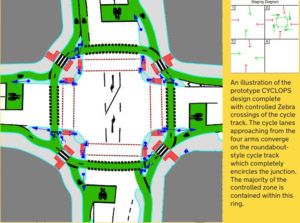
Current UK junction designs typically position people on bikes in the nearside of the lane, allowing vehicles to pass on their offside. This can cause so-called ‘left hook’ incidents, where cyclists going ahead are struck by a vehicle turning left from the same lane. The CYCLOPs approach solves this issue as well as delivering a range of other benefits, including:
- Cyclist and pedestrian phases can run simultaneously;
- Pedestrian crossing times are shorter and closer to desire lines, including the potential for diagonal pedestrian crossings;
- Cyclists can filter left without signal control;
- Journey times for all modes navigating the junctions are not negatively affected, including motor traffic.
The approach is likely to be adopted by several other UK cities including Cambridge and Aberdeen, which are progressing plans based on TfGM’s CYCLOPS design template.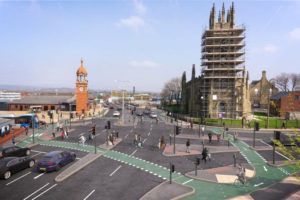
“Junctions are where most collisions occur and can be a scary experience for people travelling without cars. If people are faced with one or more of these stressful experiences on a journey, in many cases, they simply opt to jump in the car, so tackling this is a top priority. Our traffic engineers have come up with a world-leading junction design that will be introduced in towns and cities, not only across the UK, but abroad too,” explained Greater Manchester’s cycling and walking commissioner, Chris Boardman. “The CYCLOPS approach makes foot and bike travel far safer and more direct without disrupting other modes. It is frankly genius and we’ll soon be wondering why we ever did anything else. I can’t wait to see the first one installed in Greater Manchester.”
Internationally, the approach has been recognized by Skye Duncan, director of the Global Designing Cities Initiative at the USA’s National Association of City Transportation Officials (NACTO). She noted, “It is great to see Greater Manchester embrace the concept of protected intersections for cyclists. This is a new global approach to design and each country is finding its own way to deliver them. We are particularly excited that their approach allows for diagonal movement for people walking and protection for cyclists where they need it most. It is great to see that Manchester has not just signed up to use our Global Street Design Guide, but is actively developing plans to deliver on the measures we promote; to put pedestrians and cyclists first.”


